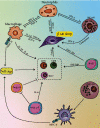Two to Tango: Dialogue between Adaptive and Innate Immunity in Type 1 Diabetes
- PMID: 32802890
- PMCID: PMC7415089
- DOI: 10.1155/2020/4106518
Two to Tango: Dialogue between Adaptive and Innate Immunity in Type 1 Diabetes
Abstract
Type 1 diabetes mellitus (T1DM) is a long-term and chronic autoimmune disorder, in which the immune system attacks the pancreatic β-cells. Both adaptive and innate immune systems are involved in T1DM development. Both B-cells and T-cells, including CD4 + and CD8 + T-cells, as well as other T-cell subsets, could affect onset of autoimmunity. Furthermore, cells involved in innate immunity, including the macrophages, dendritic cells, and natural killer (NK) cells, could also accelerate or decelerate T1DM development. In this review, the crosstalk and function of immune cells in the pathogenesis of T1DM, as well as the corresponding therapeutic interventions, are discussed.
Copyright © 2020 Lin Sun et al.
Conflict of interest statement
The authors declare that there is no conflict of interest regarding the publication of this article.
Figures

References
-
- Liu X., Zhang S., Li X., Zheng P., Hu F., Zhou Z. Vaccination with a co-expression DNA plasmid containing GAD65 fragment gene and IL-10 gene induces regulatory CD4(+) T cells that prevent experimental autoimmune diabetes. Diabetes/Metabolism Research and Reviews. 2016;32(6):522–533. doi: 10.1002/dmrr.2780. - DOI - PubMed
Publication types
MeSH terms
LinkOut - more resources
Full Text Sources
Medical
Research Materials

